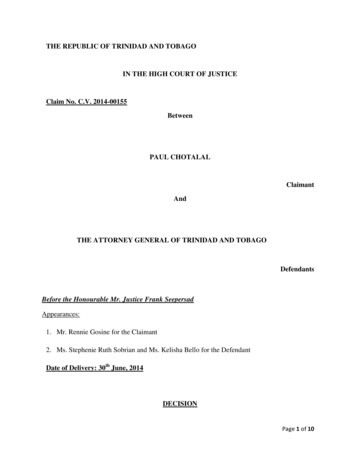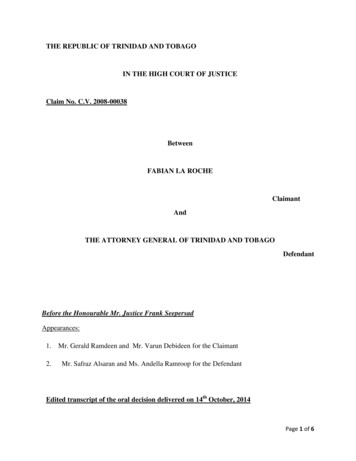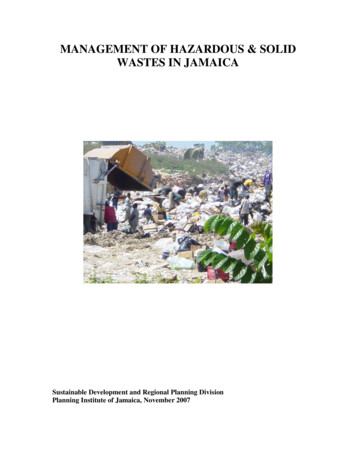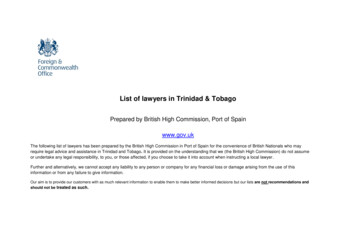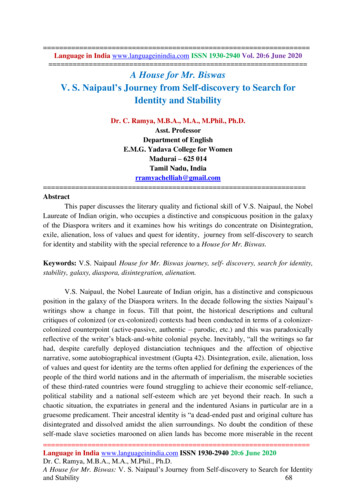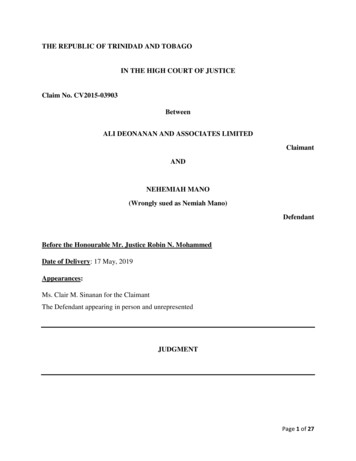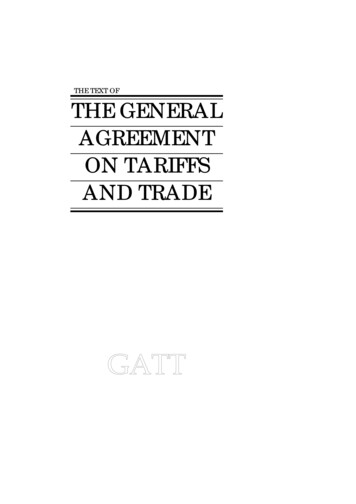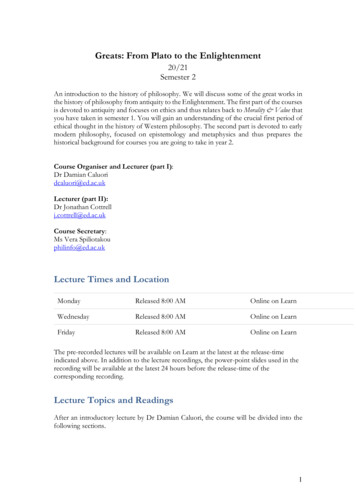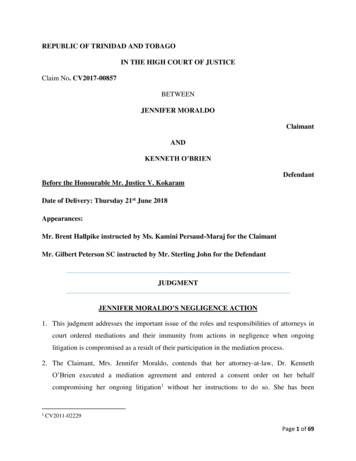
Transcription
REPUBLIC OF TRINIDAD AND TOBAGOIN THE HIGH COURT OF JUSTICEClaim No. CV2017-00857BETWEENJENNIFER MORALDOClaimantANDKENNETH O’BRIENDefendantBefore the Honourable Mr. Justice V. KokaramDate of Delivery: Thursday 21st June 2018Appearances:Mr. Brent Hallpike instructed by Ms. Kamini Persaud-Maraj for the ClaimantMr. Gilbert Peterson SC instructed by Mr. Sterling John for the DefendantJUDGMENTJENNIFER MORALDO’S NEGLIGENCE ACTION1. This judgment addresses the important issue of the roles and responsibilities of attorneys incourt ordered mediations and their immunity from actions in negligence when ongoinglitigation is compromised as a result of their participation in the mediation process.2. The Claimant, Mrs. Jennifer Moraldo, contends that her attorney-at-law, Dr. KennethO’Brien executed a mediation agreement and entered a consent order on her behalfcompromising her ongoing litigation1 without her instructions to do so. She has been1CV2011-02229Page 1 of 69
unsuccessful in a separate action to set aside that consent order2 principally on the basis thatshe had agreed to settle the proceedings and that her attorney had an implied and ostensibleauthority to settle those proceedings on her behalf. She now claims damages for negligenceagainst her attorney for having submitted that mediation agreement and consent order to theCourt without her instructions. However, a fundamental question raised by her attorney inthis claim, before addressing any alleged breach of duty or loss, is whether “attorneyimmunity” as prescribed by statute and the common law affords this attorney a completedefence to Mrs. Moraldo’s claim. In my view it does.3. The Mediation Act Chapter 5:32 confers an immunity to both the mediator and the attorneyfrom any claim arising out of any act done or omitted to be done in the course of themediation process. Additionally, the Legal Profession Act Chapter 90:03 has codified thecommon law espoused in Rondel v Worsley [1967] 3 WLR 1666 and Saif Ali And AnotherRespondents And Sidney Mitchell & Co. (A Firm) And Others Appellants [1978] 3WLR 849, in conferring an immunity on attorneys for the conduct of litigation which extendsto any pre-trial work intimately connected with the manner in which the matter is conducted.The decision of an attorney to settle or compromise a pending claim falls within thisimmunity. Not only does it fall squarely within the four corners of the statute as an act donein the conduct of litigation but there are sound policy reasons for conferring such immunityon attorneys to protect such decisions made and advice given which result in a settlement orcompromise of litigation arising out of court ordered mediation.4. It must be understood at the outset that the Courts in this jurisdiction robustly encourageparties and their attorneys to utilise mediation as an effective method to resolve disputes. TheCourt’s role in civil litigation is no longer seen as ushering cases towards a trial as thoughthat is an inevitable event to resolve a claim. A trial is a last resort to the resolution of claimsin our Courts. Rather, instead, the role of the case managing Judge under the CivilProceeding Rules 1998 as amended (CPR) is to assist the parties to identify the issues indispute and the suitable methods for their resolution whether by way of mediation, judicialsettlement conferences (JSCs), expert determination, adjudication or other suitable means.There is no doubt that the settlement or compromise of actions are welcomed and facilitated2Jennifer Moraldo v Anthony Sandiford CV2016-01946 (Jennifer Moraldo’s setting aside action)Page 2 of 69
by the Courts as ultimately a solution driven by the parties themselves. Such solutions onmost occasions are superior to one imposed by the Court after a judicial determination at atrial. To that extent the case managing Judge and the attorneys are active collaborators inassisting clients to arrive at such just resolutions. Indeed all parties are enjoined to assist theCourt to give effect to the overriding objective of the CPR3. By extension, court annexedmediators are collaborators in this system of civil justice and the Mediation Act has set outextensive regulations to standardise and monitor such practices to ensure an acceptable levelof quality which would not compromise the overall system of justice and the client’s accessto justice.5. I emphasise this from the outset as, contrary to the submissions made by Counsel for theClaimant, attorneys do play an important role at court ordered mediations and it is not theexpectation of our Courts that when a matter is referred to mediation by a Court that theattorney simply abandons the client. To the contrary, attorneys ought not to assume that theirclients who attend court ordered mediation have dispensed with the need for legal services.In the preparation for court ordered mediation, the conduct of that mediation and the postmediation phases, attorneys must continue to discharge their duties to their client, the Courtand to the wider society and to resolve any ethical dilemmas that may arise where theseduties inevitably intersect with one another.6. While there are as yet no codes of conduct for attorneys in this jurisdiction that specificallygovern mediation either in the Legal Profession Act or the Mediation Act, the role of theattorney in mediation undoubtedly takes on a new dimension fashionably referred to as “themediation advocate”. Such an advocate discharges his traditional ethical obligations underthe attorney’s Code of Ethics but the approach, however, is not adversarial but collaborative.The skills and services of the attorney to zealously protect or pursue a client’s cause are nowengaged to assist the client in the mediation process in a problem-solving model to helpobtain the best possible negotiated settlement. It is important for attorneys to acknowledgethat new role that they assume in mediation.7. As the Hon T F Bathurst quite rightly observed:“A key strength for the successful lawyer is the ability to switch hats and transform from3Civil Proceeding Rules 1998 as amended (CPR)Page 3 of 69
adversarial court advocate one day, highlighting the strengths of a client’s position, todispute resolution advocate the following day, participating in collaborative problemsolving and encouraging a client to move away from a position, think creatively andaccept compromise.”48. Although an attorney, like a mediator, may be immune from actions, both are liable to bedisciplined for breach of their ethical duties towards the parties or clients. In the case of themediator, a breach of the mediator’s Code of Ethics would result in sanctions by theMediation Board of Trinidad and Tobago. In the case of the attorney, a breach of his ethicalduties would result in disciplinary action by the Disciplinary Committee. As mediation growsin popularity in this jurisdiction, such liabilities demonstrate that the attorney at law mustkeep in step with his obligations and responsibilities to his client in the mediation room.9. In this case, the attorney’s alleged breach of duty was to enter into a mediation agreementwithout the express authority of his client. I have found on the facts in the case that while theclient did enter into an oral agreement at the mediation session which was subsequentlyreduced into writing by the mediator and executed by the attorney, the client, Mrs. Moraldowas not informed of the entering of the consent order by her attorney. As a consequence,although the client had agreed to settle the claim on the terms of the mediation agreement,the consent order which was presented by Dr. Kenneth O’ Brien was done without hisclient’s specific knowledge.10. An attorney no doubt has the authority to compromise proceedings on behalf of his client.The entering of a consent order in terms of a mediation agreement in court ordered mediationmay be seen as a natural consequence of the client agreeing to terms to compromise a claim.Effective communication with the client is essential to avoid any allegations of actingwithout instructions which is tantamount to a failure to comply with the ethical duties andresponsibilities expected of the reasonable professional. This judgment examines the extentto which the attorney immunity should protect such decisions by attorneys which brings ahalt to the litigation and is not related to its continuing conduct and management. It is thedifficulty in drawing artificial lines or examining the “jagged edge” of attorney immunity4Off With The Wig: Issues That Arise For Advocates When Switching From The Courtroom To The NegotiatingTable Australian Disputes Centre 30 March 2017Page 4 of 69
which has spurred some Commonwealth jurisdictions to abolish the immunity altogether, amatter which may yet engage the professional bodies of attorneys and mediators in thisjurisdiction.11. In dealing with this claim I examine three main questions:a) Whether Dr. O’Brien had the authority of Mrs. Moraldo to enter into the consentorder;b) If not whether in doing so it was an act which is intimately connected with theconduct of the litigation or in reference to the mediation process and therefore he isimmune from an action in negligence;c) If he is not immune whether he acted negligently and what is the extent of his client’sloss.512. These questions arise from the following factual context.Brief Facts13. Mrs. Moraldo retained Dr. Kenneth O’Brien to act for her in various matters and he was alsoretained by her as the Defendant in High Court Action CV2011-022296 to protect herinterests and to defend a claim by Mr Anthony Sandiford for the possession of property7. Inthose proceedings Mr. Anthony Sandiford had brought a claim against Mrs. Moraldo forpossession of his property (The East Apartment) at No. 104 Capildeo Land, Cleaver Road,Arima. She counterclaimed that she was entitled to the East Apartment at No. 104 CapildeoLand, Cleaver Road, Arima. For both parties their entitlement to be in possession of the saidpremises was at stake and a negative outcome at a trial would have meant for either of themlosing their property at No. 104 Capildeo Land, Cleaver Road, Arima to the other.14. At the stage of the pre-trial review the parties were, by consent, referred to mediation by theCourt. The mediation was conducted by Mr. Anthony Vieira on February 2013, a certifiedThe Defendant did raise the issue that the claim was statute-barred but that defence upon the Court’s enquiry wasabandoned by Counsel for the Defendant before the judgment was delivered and quite rightly so. The Court will notapprove of limitation defences in cases of negligence against attorneys at law.6Anthony Sandiford v Occupants of the property known as the “East Apartment” of the property located at No. 104Capildeo Lands, Cleaver Road, Arima, Jennifer Moraldo (Legal Personal Representative of the Estate of ElaineSandiford) Sharmaine King (Proposed Legal Personal Representative of the Estate of Arnold Sandiford).7He was retained in two related matters Anthony Sandiford v Arnold Sandiford CV2008-01690 and JenniferMoraldo v Anthony Sandiford CV2009-043305Page 5 of 69
mediator under the Mediation Act. After the end of the mediation session the mediator drewup the agreement of the parties in his office and sent it to the attorneys at law for both parties.The attorneys executed it and sent it to the Court’s Judicial Support Officer (JSO) under ajoint letter indicating that the matter was settled in the terms of the mediation agreement anddesiring to enter into a consent order in terms of the agreement. A consent order wassubsequently drawn up by the Judge in Chambers without a further hearing and issued to theparties.15. There is no dispute in this case that Mrs. Moraldo and her attorney Dr. O’Brien together withMr. Sandiford and his attorney Ms. Turkessa Blades attended the mediation session and thatthe mediation agreement was subsequently drawn up and entered as a consent order. Mrs.Moraldo’s case of negligence against Dr. O’Brien is not one of failing to give proper advice.It is not a case of failing to advise on the proposed settlement or to make properrepresentation to obtain a just result for Mrs. Moraldo. It is not a case of any failure of Dr.O’Brien as an attorney at law in representation or guidance in the mediation process at all. Itis simply that Mrs. Moraldo contends that Dr. O’Brien entered into the consent order withouther instructions to do so and by failing to represent Mrs. Moraldo’s case to the Court duringthe proceedings. Mrs. Moraldo contends that he breached his fiduciary duties by:a) Acting without informing the Claimant or obtaining the Claimant’s instructions;b) Deliberately concealing the true actions and the nature of the communication betweenhimself and the Court in the said matter.16. Importantly, there is no specific claim for damages for negligence, but she seeks severaldeclaratory reliefs that Dr. O’Brien breached his duty towards her and seeks the repayment offees she paid to him in the sum of 100,000.00. It was not part of her pleaded case that themeasure of her loss arose is referable to the terms of the agreement.17. Dr. O’Brien in his defence denies that Mrs. Moraldo instructed him of any change in herposition with regard to the agreement during the mediation process or after it. The mediationagreement was executed by Dr. O’Brien and Counsel for Mr. Sandiford following themediation session in the presence of Mrs. Moraldo and with her full knowledge and consent.Page 6 of 69
18. In 2015, Mrs. Moraldo, through her husband, indicated that she was unable to secure themoney to satisfy the judgment and it was on that basis Mrs. Moraldo’s husband requested Dr.O’Brien to set aside the consent order. Dr. O’Brien denies that he gave any undertaking to dosame.19. He contends that he was present at the hearings before the Court and due to the fact thatmediation was ordered in the proceedings with a view of amicably settling the matter, therewas no need for him to put forward any further defence on behalf of Mrs. Moraldo. Hefurther denies that he received the sum of 100,000.00 and contends that he did not breachthe fiduciary duty owed to Mrs. Moraldo.20. By way of context, Mrs. Moraldo also brought a claim against Mr. Sandiford to set aside theconsent order in Jennifer Moraldo v Anthony Sandiford CV2016-01946 (the setting asideaction). In that case, this Court has already found that there was a clear agreement made bythe parties at the mediation session which was subsequently drawn up by the mediator andthe attorneys for Mrs. Moraldo and Mr. Sandiford. Dr. O’Brien had the ostensible andimplied authority to enter that consent order and to bind his client in circumstances whereMr. Sandiford was unaware of any dispute between Dr. O’Brien and his client. Mr. Sandifordacted at all material times on the faith of the agreement and consent order that was enteredbetween the parties. The consent order was not set aside.21. Against this backdrop, I turn to the first issue for determination of the authority of Dr.O’Brien to act for Mrs. Moraldo in executing the mediation agreement and consent order.I (i) The authority of Dr. O’Brien to execute the mediation agreement22. The Mediation Act defines the mediation process as ending with the execution of a mediationagreement:“Mediation process” includes the mediation session together with all administrativeprocesses and procedures leading to and necessary for the conduct of such mediationsession and all processes and procedures after the completion of the mediation sessionending with the signing of the mediation agreement or if there is no agreement, when themediation session is otherwise terminated.”Page 7 of 69
23. The mediation process therefore ends upon the execution of the mediation agreement orwhen the session is otherwise terminated. In this case, the mediation agreement was notexecuted by the parties at the mediation room but was subsequently drawn up by themediator and executed by the attorneys. It is of course a matter of good practice formediation agreements to be executed at the end of the mediation session. However, therewould be many reasons why the execution of a mediation agreement may be postponed afterthe end of the mediation session. In this case the mediation ended late in the day and themediator undertook to draft the agreement based on the notes of the agreement he recordedwith the concurrence of the parties. To that extent, the mediation process is still extant. It isstandard practice that the written memorandum of the agreement is immediately prepared andsigned before the parties leave. However, the practice of mediation suggests that thefacilitating of the drafting of the agreement at a later stage by the mediator may also occur.See ADR Principles and Practice 3rd Edition page 255.24. The manner in which the mediation agreement was executed in this case does not excite theCourt’s suspicion, nor has Mrs. Moraldo proven on a balance of probabilities that it wasexecuted without her knowledge nor consent.25. In analysing the evidence in this case of whether there was an agreement, I dealt with thequestion of the admissibility of confidential information at the mediation session in thesetting aside judgment. I adopt that reasoning in my analysis of the evidence in this case. Seeparagraphs 43-55 of Jennifer Moraldo v Anthony Sandiford CV2016-01946.26. I make this main finding of fact based upon my analysis of the evidence in this case and thecredibility of the witnesses who have testified on this issue namely, Mr. Keith Moraldo andMrs. Moraldo for the Claimant, Dr. O’Brien for the Defendant and Mr. Vieira who respondedto the summons issued by the Court to assist it in determining whether the agreementpresented to this Court were the terms agreed to by the parties.27. The well-known authorities of Reid v Dowling Charles and Percival Bain Privy CouncilAppeal No. 36 of 1987 and The Attorney General of Trinidad and Tobago v AninoGarcia Civil Appeal No. 86 of 2011 are pertinent guides in determining the credibility ofwitnesses where less emphasis is placed on demeanour and more emphasis is placed on aforensic analysis of the witness testimony.Page 8 of 69
28. In The Attorney General v Anino Garcia CA Civ. 86/2011 Bereaux JA placed emphasis onthe assessment of the credibility of witnesses as against the pleaded case, contemporaneousdocuments and the inherent probabilities of the rivalling contentions. He adopted theguidance of the Privy Council in Reid v Dowling Charles and Percival Bain Privy CouncilAppeal No. 36 of 1987 at page 6 where the Court noted:“Where the wrong impression can be gained by the most experienced of judges if herelies solely on the demeanour of witnesses, it is important for him to check thatimpression against contemporary documents, where they exist, against the pleaded caseand against the inherent probability or improbability of the rival contentions, in the lightin particular of facts and matters which are common ground or unchallenged, or disputedonly as an afterthought or otherwise in a very unsatisfactory manner. Unless thisapproach is adopted, there is a real risk that the evidence will not be properly evaluatedand the trial judge will in the result have failed to take proper advantage of having seenand heard the witnesses. ”29. In Mahabir Industries Limited v Winston Moore, Mohammed J opined at paragraphs 3133:“[31] Before arriving at a conclusion, the court ought to “weigh in the balance matters ofsubstantive evidence which bear on the question of whether a particular witness was orwas not telling the truth”: Ramsaran v Hoodan (unreported) Privy Council App. No 5 of1997 (the Privy Council noting with approval the words of de la Bastide CJ in the Courtof Appeal judgment of that case). It is well-established that in doing so, a first instancetrial judge can take into consideration observations in respect of the non-verbalcommunication that accessorizes a witness’ oral testimony while the witness is beingexamined or cross-examined. Where the version of facts proffered by each side isdiametrically opposed the court ought to consider the credibility and reliability of thewitnesses in determining what is more likely to be the truth.[32] Throughout, however, as cautioned by the Privy Council in Attorney General andanor. v. Kalicklal Bhooplal Samlal (1987) 36 WIR 382 it must be borne in mind thatthe trial judge must balance the demeanor of the witnesses against the rest of theevidence. The trial judge must, when weighing the credibility of a witness, put correctlyPage 9 of 69
into the scales the important contemporaneous documents and inherent improbabilities.This principle was concisely put in the headnote of the Privy Council’s judgment inKalicklal (supra), per curiam, as follows: "Before a trial judge forms a view based on thedemeanour of a witness on a matter on which there is a conflict of evidence, he mustcheck his impression on the subject of demeanour by a critical examination of the wholeof the evidence (in this case, the contemporaneous documents and the inherentimprobability.).”[33] The court’s final determination on the issue of fact should: (i) be based on the factsas properly deduced from the matter; (ii) have much support in the evidence; and (iii) bea decision which a reasonable judge could have reached: deduced from AttorneyGeneral of Trinidad and Tobago and Anino Garcia CA No. 86 of 2011. Of course, acourt should always have due regard to the particular circumstances of a matter whendetermining an issue of fact: Attorney General for the Isle of Man v Moore (1938 3All ER 263 (Privy Council).”30. I was very impressed with Mr. Vieira’s evidence. He gave his evidence in a candid and openmanner. Where there were any inconsistences he quickly owned up to them and gavecredible explanations for any discrepancies in his evidence. His evidence, of course, wasgiven against the backdrop of having conducted the mediation some five (5) years ago.Nevertheless, the clarity with which he answered his questions and the willingness withwhich he responded to the Court’s invitation are to be commended. A mediator is in fact notcompellable as a witness, however, Mr. Vieira himself was quick to point out to the Court,when he first presented himself, of the exceptions to the confidentiality rules and hisobligation to assist the Court to determine whether an agreement was arrived at between theparties. I also took note of the fact that there was no motive nor interest of Mr. Vieira to beserved in supporting either party. His deportment and answers to questions confirmed hisstatus as a true neutral in this dispute8. Indeed I took careful note of both Mr. and Mrs.Moraldo’s reticence under cross examination in accusing Mr. Vieira of lying and whenconfronted with the fact that their testimony irreconcilably conflicts with Mr. Vieira8Code of Ethics in the Mediation ActPage 10 of 69
suggesting that Mr. Vieira has lied, their answers were non-committal and drew short ofmaking any negative inferences of Mr. Vieira.31. Ultimately his evidence was consistent, clear, without any hint of prevarication nor of anyinterest to serve save for assisting this Court in determining whether the parties agreed to theterms set out in the agreement. It is fitting to analyse Mr. Vieira’s evidence first as it servesin many respects as a compass in guiding this Court in the determination of the credibility ofthe parties on this aspect of the case.32. In his evidence in chief he contended that he recalled conducting a mediation session in2013. He was assured at the start of the mediation that all persons who were needed in orderto give a binding agreement were present and that their lawyers had authority to act andspeak on their behalf. The mediation lasted for several hours and it seemed doubtful as towhether an agreement would be arrived at but eventually they did arrive at an agreement. Hecontended that the consent dated 13th March, 2013 represented his understanding of what wasagreed. He stated that at the end of the mediation session, the agreement was written out inmanuscript and the parties initialled the hand-written agreement.33. In cross examination by Counsel for the Claimant, Mr. Vieira admitted that the matter wasvery contentious and that he did not think the parties would have arrived at an agreement. Hecontended that the attorneys for both parties were there throughout the mediation. He statedthat “the mediator tries to encourage the parties to be the ones to participate and to speak andto do the agreement and the attorneys are there for ostensibly to give advice to make surelegal points arise but often times the attorneys engage with the parties in the discussions.”34. He contended that when they arrived at the mediation agreement, he read out the terms, thelawyers on each side kept notes and then the agreement was typed up in keeping with thosenotes. He stated:“What happened as I said is, at the end of the session I read over the terms what Iunderstood the agreement to be, I said I would have it typed up so it can be put as a courtorder as annexed to the court. I took my manuscript, I had it typed and I sent it to the two(2) lawyers for them to see if it properly represented what was agreed at the mediationsession. There were some delay as you say here for probably waiting for receipts andother documentation, but eventually the two (2) lawyers got back to me. They said it wasPage 11 of 69
fine, this represented what was agreed in the session. I signed off on it and I gave it tothem to put in.”35. In the setting aside action I held that his testimony established the following facts:(a) The parties and their attorneys at law attended the mediation session.(b) There was a pre-mediation and a main mediation session.(c) It was a difficult mediation.(d) He employed the process of caucusing to break the deadlocks between the partiesand to keep the negotiations continuing.(e) Mrs. Moraldo was represented by her attorney Dr. O’Brien and Mr. Sandifordrepresented by Ms. Blades. All present had full authority to settle the claim.(f) All parties present were allowed to speak and to participate in the negotiations.(g) The mediator recorded the terms of settlement. This was read over to the partiesat the end of the session and all agreed to the terms.(h) The mediator was unsure as to whether the parties had themselves initialled hisdraft of the agreement however he took his notes back to his office and as agreedby them he later typed up the agreement, signed it and sent it to the respectiveattorneys.(i) Both attorneys eventually executed the agreement.36. It was not suggested to Mr. Vieira in cross examination that the agreement which he typed upwas not the terms that were discussed in the mediation room nor was it suggested to him thatthe parties did not agree to any terms at the end of the mediation session. When questionedby Counsel for the Claimant if he heard Mrs. Moraldo in cross examination say she did notagree nor did she sign an agreement, he indicated that he did. He was then questioned byCounsel that at that point there was probably a draft proposed agreement and not an actualagreement but he maintained that there was an agreement. Mr. Vieira’s consistent answer incross examination of what transpired at the end of the mediation session was that he read theterms of the agreement, the parties agreed, he later drafted it out and sent it back to theattorneys for Mrs. Moraldo and Mr. Sandiford to confirm that it represented what theyPage 12 of 69
discussed and agreed. The attorneys eventually responded that they did and that it was goingto be entered into as a consent order. The mediation agreement was in the following terms:“This Agreement dated and effective thisday of February 2013 is made between (1)Jennifer Moraldo; and (2) Anthony Sandiford.It is Agreed:1. Matter settled for Nine Hundred Thousand Dollars (TT 900,000.00) and acongruent transfer of property, specifically:a) Jennifer Moraldo will pay Anthony Sandiford the agreed sum ofTT 900,000.00 on or before 31 December 2013; andb) Anthony Sandiford will convey the property in Arima known as 104Capildeo Land, Cleaver Road in Arima to Jennifer Moraldo (preferablyby Deed of Gift but if that’s not feasible then otherwise by Deed ofConveyance; the costs and charges associated with the transfer to beborne by Jennifer Moraldo). The Deed of Gift/Transfer shall be preparedand signed forthwith and in any event before 31 December 2013, but willbe held in escrow until the agreed sum has been paid. If Jennifer Moraldoneeds more time to pay the agreed sum Anthony Sandiford will be entitledto statutory interest (12%) from 31 December 2013 to the date of finalpayment inclusive.2. All further proceedings (including HCA CV2008-01690 and HCA CV2010-5045)stayed upon the terms set out above.3. The parties acknowledge that the above terms represent their complete agreementrelating in property and finance and it constitutes full and final satisfaction of alland any claims either may have against the other.4. Each party acknowledges and agrees that upon complete compliance by eachother with the terms of this Agreement and with any Order made embodying orreflecting it, these proceedings and all other proceedings (including HCACV2008-01890 and HCA CV2010-5045) do stand dismissed and neither partywill have any further claims upon the other including any claims upon her or hisrespective estates.Page 13 of 69
5. Each party will bear their own costs with respect to this Agreement and thereshall be no order as to costs in these and the other proceedings.6. This Agreement shall be filed and made an Order of the Court.7. There shall be liberty to both parties to apply as to carrying the agreed terms intoeffect.Concurrence of the MediatorThe general provisions contained in the foregoing Agreement were reached by
2. The Claimant, Mrs. Jennifer Moraldo, contends that her attorney-at-law, Dr. Kenneth O'Brien executed a mediation agreement and entered a consent order on her behalf compromising her ongoing litigation1 without her instructions to do so. She has been 1 CV2011-02229
